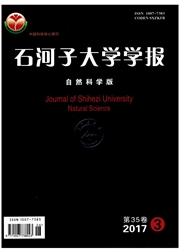

 中文摘要:
中文摘要:
为了探讨NaCl胁迫对酸枣幼苗光合生理特性的影响,本研究以水培的酸枣幼苗为试材,研究不同浓度NaCl(0、50、100、150、200 mmol/L)处理对酸枣幼苗光合作用和叶绿素荧光特性的影响。结果表明:与对照相比,随着NaCl胁迫天数和浓度的加大,酸枣幼苗叶片的净光合速率(Pn)、气孔导度(Gs)、蒸腾速率(Tr)、最大荧光(Fm)、PSⅡ原初光能转化效率(Fv/Fm)、光合电子传递速率(ETR)、光化学猝灭系数(qP)均降低,初始荧光(Fo)、非光化学猝灭系数(NPQ)升高、胞间CO_2浓度(Ci)先降低后升高,各指标变化幅度由大到小对应的浓度分别是200 mmol/L〉150 mmol/L〉100mmol/L〉50 mmol/L。NaCl胁迫导致酸枣幼苗光合作用下降的原因是导气孔限制转变成非气孔限制,同时PSⅡ反应中心光合机构受损,引起其光能原初捕捉能力和光合电子传递速率下降,最终导致酸枣幼苗光合作用能力的减弱。
 英文摘要:
英文摘要:
In order to improve the sah tolerance of jujube and provide reference for reasonable utilization of saline land, the effects of different concentrations of NaC1 stress (0, 50, 100, 150 and 200 mmol/L) on photosynthesis and chlorophyll fluorescence characteristics of wild jujube seedlings were investigated in this study. The results showed that compared with the control, with the increase of NaC1 concentrations and stress times, the net photosynthetic rate (Pn), net stomatal conductance (Gs), transpiration rate (Tr), maximum fluorescence yield (Fro) and PS II efficiency of primary conversion of light energy (Fv/Fm), photosynthetic electron transport rate (ETR), and photochemical quenching coefficient (qP) decreased; initial fluorescence (Fo), non-photochemical quenching (NPQ) increased; intercellular CO2 concentration (Ci) decreased first and then increased. The decreasing amplitude of each index increased with the increase of concentration, which was 200 mmol/L 〈 150 mmol/L 〈 100mmol/L 〈 50 mmol/L. The photosynthesis of sour jujube under NaC1 stress was mainly limited by non-stomatal factors rather than stomatal factors. Furthermore, NaC1 stress damaged the PS II reaction center, caused the primary capture capacity and the photosynthetic electron transport rate decrease, resulting in the reduced ability of photosynthesis in sour jujube in the end.
 同期刊论文项目
同期刊论文项目
 同项目期刊论文
同项目期刊论文
 期刊信息
期刊信息
